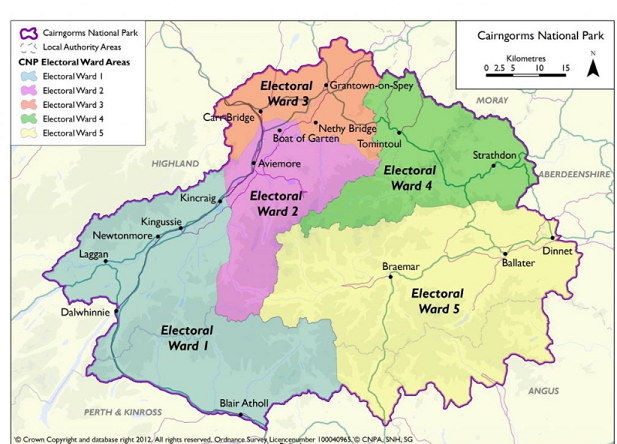
Following my post on the Cairngorms National Park local elections (see here), which will be decided by postal vote on Thursdays 21st March, nominations for people wishing to stand close next week, at 4pm on Wednesday 13th February. Its really important for democracy and for the future of the National Park that local residents have a real choice of who to vote for in these elections. This post takes a look at the issues and what the Cairngorms National Park Authority and Highland Council have been doing about this.
Why people should consider standing for election
The Cairngorms National Park Authority has, with the assistance of Highland Council who run the elections on their behalf, been disseminating information encouraging people to stand for several months now. The CNPA has produced an excellent video, featuring Xander McDade their new convenor, encouraging people to put themselves forward for election (see here). They also have another good video, featuring 4 Board Members, about what’s involved (see here). I hope that people inspired by watching what is said in the videos might then be tempted to read the rather drier text about how to do so (see here).
Not many people realise that you don’t have to be resident in one of the five wards (map above) or even within the National Park to stand. Highland Council and the CNPA have, to their credit, made it easier for people to put themselves forward for election than in the Loch Lomond and Trossachs National Park. There, nominations had to be supported by ten people resident in the Ward concerned. To stand in the Cairngorms Local Member elections you need, besides a proposer and seconder, signatures from just four other people resident in the ward concerned. That makes it easier for both local residents and people from outside the area to stand. Its to be welcomed and is good for democracy.
The reason why all of this is important is illustrated by the 2015 local member elections. In Ward 4 there was just one candidate, Eleanor Mackintosh, who is now Convenor of the Planning Committee. She was consequently elected unopposed. Local electors therefore had no choice. Love her or hate her, that was not good for democracy or the National Park.
The question of giving electors a choice is potentially complicated by the first past the post system and I believe this remains a dampener on democracy in our National Parks. Too many candidates with one point of view and the vote for that point of view – for example people concerned about the intensification of grouse moor management in the National Park and the impact this is having on the landscape – risks being split. In the Loch Lomond and Trossachs National Park Authority elections (see here) two of the successful local candidates were elected with less than a 30% share of the vote (one had just 17% of the vote). That seems to me an incredibly strong argument for introducing the Single Transferable Vote.
In the last CNPA elections, however, this would only have been an issue, in one electoral ward, Ward 5, where Katrina Farquhar (who subsequently stepped down) did not receive an absolute majority of the votes cast . This was the only ward where there were more than three candidates but, notably, the turnout was almost twice that of any other ward:
Turnout and candidates 2015
Ward 1 28.36% (2 candidates)
Ward 2 28.52% (3 candidates)
Ward 3 24.59% (3 candidates)
Ward 4 Uncontested
Ward 5 47.4% (4 candidates)
Katrina Farquhar also secured a fairly resounding victory (514 versus 296, 209 and 155 votes for the other three candidates and might well have been voted in under a Single Transferable Vote system).
Its therefore very difficult to predict the risk of splitting votes but if, by encouraging people to stand (which is the right thing to do), the CNPA ends up with people elected on a small proportion of the votes cast, I hope they will be prepared to use this as a reason for changing the electoral system.
Encouraging people to vote
Having a choice of candidates is only one part of the democratic equation. It only works if people know what the different candidates stand for and what might be at stake. Often people don’t, which partly explains the very low voter turnout.
I have previously commented about the ridiculously low levels of election expenses allowed in the LLTNPA elections (£100) (see here), how this effectively prevented candidates being able to put across their point of view (no money for meetings, leaflets etc) and favoured well kent people like existing Councillors. I was delighted to see therefore that in the CNPA elections the expenses limit has been increased to £250, the same as for Local Council Elections. I do not know how Highland Council has managed to do this but they are to be congratulated. I hope it enables candidates to be able to make their skills and views far more widely known.
Being able to spend a little money is, however, only one part of enabling candidates to make their views known. It would also help if the CNPA were to encourage as many Community Councils as possible through the Cairngorms area to hold election hustings. The local press also has a key role to play. Speyside is fortunate enough to have an excellent local paper that covers many of the issues which feature on Parkswatch and are so central to the future of the National Park. It could play a key role in helping raise voter turnout.
Meantime on Parkswatch I will try and cover some of the key issues facing each area within the National Park before the elections and, as always, remain open to contributions on specific issues (including from people putting themselves forward for election).

1 Comment on “The forthcoming elections in the Cairngorms National Park”